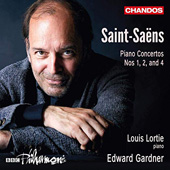

When the name of Camille Saint-SaŽns (1835-1921) crops up during a conversation on music, most of the talk revolves around his famous Carnival of the animals, the Danse macabre, or the Symphony No. 3 (Organ Symphony). When in fact he composed many songs, operas, chamber music, five symphonies and five piano concertos, all of which are excellent incursions in their respective genres. Mind you the Piano Concerto No. 1 in D major, Op. 17 leans more toward flashy presentation than substance, what with its two external movements focusing your attention on the orchestral writing, with spasmodic bursts of virtuosic piano runs. The beautiful, funereal slow movement sandwiched in between makes up for that with its Bach-inspired melody and stronger focus this time on the piano part, which definitely sets the tone. And I must say the long extended piano runs in the middle of the final Allegro movement sound like the wind under Louis Lortie's hands. There's a delicacy and gracefulness to his touch throughout this recording that suits this music very well.
The piano opens the Piano Concerto No. 2 in G minor, Op. 22 with an extended and again Bach-influenced motif that leads to a dramatic orchestral entrance marked by decisive punctuations on the piano's discourse. The balance between piano and orchestra is more appropriate this time around with the soloist leading the way and setting the tone at all times. This is definitely a work which underlines drama and expression rather than flash. And who can resist the originality and lighthearted features of its scherzo movement.
With the Piano Concerto No. 4 in C minor, Op. 44 formalities are replaced by a more relaxed, impromptu style of writing, giving full expressive reign to the soloist. There are whiffs of his organ symphony tucked away within the Andante movement, where again the fine filigree of Lortie's touch is pure expressive magic. And the final minute or so of this concerto, in typical bravura form, caps everything with brilliant uplifting gestures.
Plans are already underway for the release of Nos. 3 & 5 with these same forces. The recordings available of No. 2 far outweigh the other four, so it would be nice to have a complete set of all five under the same hands, especially when performed and recorded this well.
Jean-Yves Duperron - September 2018